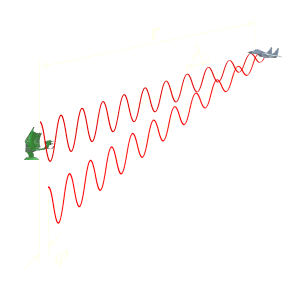Doppler- Effect

Figure 1: Doppler effect
Doppler- Effect
In radar technology the Doppler Effect is using for the following tasks:
- Speed measuring;
- MTI - Moving Target Indication;
- in air-or space-based radar systems for precise determination of lateral distances.
The Doppler- Effect is the apparent change in frequency or pitch when a sound source moves either toward or away from the listener, or when the listener moves either toward or away from the sound source. This principle, discovered by the Austrian physicist Christian Doppler, applies to all wave motion.
The apparent change in frequency between the source of a wave and the receiver of the wave is because of relative motion between the source and the receiver. To understand the Doppler effect, first assume that the frequency of a sound from a source is held constant. The wavelength of the sound will also remain constant. If both the source and the receiver of the sound remain stationary, the receiver will hear the same frequency sound produced by the source. This is because the receiver is receiving the same number of waves per second that the source is producing.
Now, if either the source or the receiver or both move toward the other, the receiver will perceive a higher frequency sound. This is because the receiver will receive a greater number of sound waves per second and interpret the greater number of waves as a higher frequency sound. Conversely, if the source and the receiver are moving apart, the receiver will receive a smaller number of sound waves per second and will perceive a lower frequency sound. In both cases, the frequency of the sound produced by the source will have remained constant.
For example, the frequency of the whistle on a fast-moving car sounds increasingly higher in pitch as the car is approaching than when the car is departing. Although the whistle is generating sound waves of a constant frequency, and though they travel through the air at the same velocity in all directions, the distance between the approaching car and the listener is decreasing. As a result, each wave has less distance to travel to reach the observer than the wave preceding it. Thus, the waves arrive with decreasing intervals of time between them.
| fD = | 2·v | fD = Doppler Frequency [Hz] λ = wavelength [m] v = speed of the wave-source [m/s] |
|
| λ |
This equation is valid, if the speed if the source of a wave is like the radial speed. But the airplane usually flies in another direction than the direction towards to the radar. Only the radial speed is then also measured. However, this is different from the aim speed so that the following equation is valid:
| fD = | 2·v | · cos α | fD = Doppler Frequency [Hz] λ = wavelength [m] v = speed of the aircraft [m/s] α = angle between the direction of the transmitted/reflected signal and the direction of flight of the target |
|
| λ |
Derivation of the Doppler-frequency formula
The phase shifting φ of an electromagnetic wave from the radar antenna to the aim and back results from the ratio of the covered distance and the wavelength of the transmitted energy multiplied with the scale of the full circle (2·π):

Figure 2: The phase shifting of the received signal
| φ = − | 2r · 2π | φ = phase-difference between the transmitted and the received signal 2r = the distance: the way and the way back 2π = 360°: the period of an oscillation λ = wavelength of the transmitted energy |
| λ |
If the aim has the radial speed
| vr = | d(r) |
| dt |
then the value of the phase changes to
| d(φ) | = | - 4π · vr |
| dt | λ |
This is equivalent to the Doppler- frequency fD according to:
| fD = | 1 | · | d(φ) | = | 1 | · | - 4π · vr |
| 2π | dt | 2π | λ |
| | fD| = | 2 · vr | = | 2 · vr· ftx | where: | ftx = is the transmitters frequency c0 = is the speed of the light vr = is the radial speed of the aim |
| λ | c0 |
This means: In practice the Doppler- frequency occurs twice at radar. Once on the way from the radar to the aim, and then for the reflected (and already afflicted by a Doppler-shift) energy on the way back.
Normalized Doppler Frequency
The Doppler frequency depends on two variables: the aims radial speed and the carrier frequency of the radar transmitter. If the frequency of the transmitter is constant, then the Doppler frequency is a measure of the radial speed. Modern radars are frequency diversity radars mostly. Their transmitters frequency isn't constant. Here the influence of different transmit frequencies is usually still low. But if the transmission frequencies are in different frequency bands, then a common radar signal processing is not possible. In digital radar signal processing, the Doppler frequency will be divided by the actual transmitted frequency in order to eliminate the influence of different transmit frequencies then:
ξD = fD / fTxNow the Doppler frequency is a measure of the radial speed only and is called “normalized”. The received echo signals from different radar frequencies can be processed in common now.


